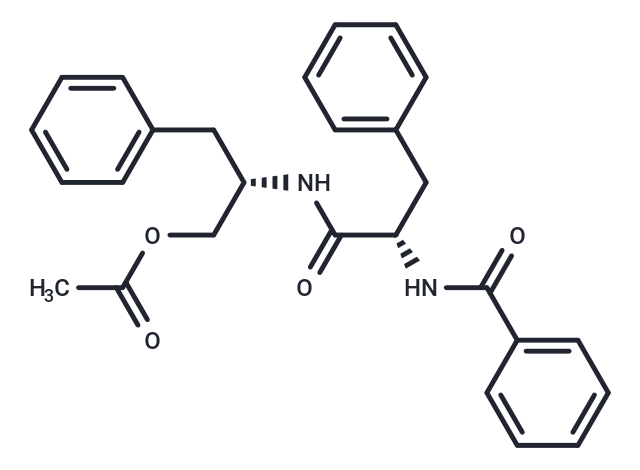Shopping Cart
Remove All Your shopping cart is currently empty
Your shopping cart is currently empty
Aurantiamide acetate (Asperglaucide) was isolated from the fermentation broth of Aspergillus penicilloides for the first time. Aurantiamide acetate is a selective and orally active cathepsin inhibitor. Aurantiamide acetate has anti-inflammatory activities and can be used for the study of inflammatory diseases[1][2].

| Pack Size | Price | USA Warehouse | Global Warehouse | Quantity |
|---|---|---|---|---|
| 1 mg | $106 | In Stock | In Stock | |
| 5 mg | $222 | In Stock | In Stock | |
| 10 mg | $328 | In Stock | In Stock | |
| 25 mg | $552 | In Stock | In Stock | |
| 1 mL x 10 mM (in DMSO) | $253 | In Stock | In Stock |
| Description | Aurantiamide acetate (Asperglaucide) was isolated from the fermentation broth of Aspergillus penicilloides for the first time. Aurantiamide acetate is a selective and orally active cathepsin inhibitor. Aurantiamide acetate has anti-inflammatory activities and can be used for the study of inflammatory diseases[1][2]. |
| Targets&IC50 | Cathepsin B:49 μM, Cathepsin L:12 μM |
| In vitro | Aurantiamide acetate decreases viability of U87 and U251 cancer cells in vitro when used at concentrations ranging from 10 to 100 μM. Aurantiamide acetate inhibited cysteine proteinases, in particular, cathepsin L and B with IC50 of 12 microM and 49 microM, respectively. |
| In vivo | Aurantiamide acetate reduces tumor growth when administered at a dose of 1 mg via intratumoral injection in a U87 mouse xenograft model. In the adjuvant-arthritic rat model, subcutaneously administered 10 mg/kg body weight of this compound suppressed hind paw swelling. |
| Synonyms | Asperglaucide |
| Molecular Weight | 444.52 |
| Formula | C27H28N2O4 |
| Cas No. | 56121-42-7 |
| Smiles | CC(=O)OC[C@H](Cc1ccccc1)NC(=O)[C@H](Cc1ccccc1)NC(=O)c1ccccc1 |
| Relative Density. | 1.179 g/cm3 (Predicted) |
| Color | White |
| Appearance | Solid |
| Storage | keep away from direct sunlight,keep away from moisture | Powder: -20°C for 3 years | In solvent: -80°C for 1 year | Shipping with blue ice/Shipping at ambient temperature. | |||||||||||||||||||||||||||||||||||
| Solubility Information | DMSO: 55 mg/mL (123.73 mM), Sonication is recommended. | |||||||||||||||||||||||||||||||||||
| In Vivo Formulation | 10% DMSO+90% Corn Oil: 2.5 mg/mL (5.62 mM), Sonication is recommeded. Please add the solvents sequentially, clarifying the solution as much as possible before adding the next one. Dissolve by heating and/or sonication if necessary. Working solution is recommended to be prepared and used immediately. The formulation provided above is for reference purposes only. In vivo formulations may vary and should be modified based on specific experimental conditions. | |||||||||||||||||||||||||||||||||||
Solution Preparation Table | ||||||||||||||||||||||||||||||||||||
DMSO
| ||||||||||||||||||||||||||||||||||||
| Size | Quantity | Unit Price | Amount | Operation |
|---|

Copyright © 2015-2026 TargetMol Chemicals Inc. All Rights Reserved.